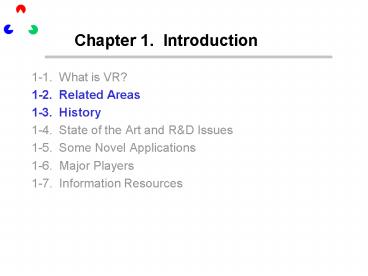Chapter 1. Introduction PowerPoint PPT Presentation
Title: Chapter 1. Introduction
1
Chapter 1. Introduction
- 1-1. What is VR?
- 1-2. Related Areas
- 1-3. History
- 1-4. State of the Art and RD Issues
- 1-5. Some Novel Applications
- 1-6. Major Players
- 1-7. Information Resources
2
1-2. Related areas
- 1. Training simulation
- 2. Tele-operation
- 3. Computer graphics
- 4. Artificial intelligence
3
training simulation
- Differences
- Re-configurable by changing software
- may include highly un-natural environment
- highly interactive and adaptive
- use of a wide variety of human sensing modalities
and sensori-motor systems - highly immersive
- near-field is synthetic far-field is synthetic.
4
tele-operation
- for at least 30 years.
- tele-operator
- directly (manually) controlled tele-operator
- tele-robot
5
- tele-operation vs. virtual reality
- tele-presence vs. virtual presence
6
(No Transcript)
7
computer graphics
- modeling
- motion control (animation)
- rendering
- user interface
8
artificial intelligence
- Studies on perception and cognition
- Testbed for AI research
9
1-3. History
- 1st stage some visionaries
- Morton Heilig
- Ivan Surtherland
- Myron Krueger
- William Gibson
10
Heligs Sensorama (1962)
- U.S. Patent
- no. 3,050,870
11
Heligs HMD (1960)
- U.S. Patent
- no. 2,955,156
12
Sutherlands 1965 vision
- Display as a window into a virtual world
- Improve image until the picture looks real
- Computer maintains world model in real time
- User directly manipulates virtual objects
- Manipulated objects move realistically
- Immersion in virtual world via head-mounted
display - Virtual world also sound real, feel real
13
Kruegers Artificial Reality
14
- 2nd stage technology development for specific
purposes - training simulator
- space exploration
- tele-operation
15
(No Transcript)
16
(No Transcript)
17
- 3rd stage VR as the general-purpose technology
- Jaron Lanier
- VR industry (VPL, Sense8, W-Industry, )
- VR academia
18
- Next stage Toward a scientific discipline
- computational reality
- a new computing paradigm
- a new media
- a new art form
- representation, creation and operation of virtual
worlds
PowerShow.com is a leading presentation sharing website. It has millions of presentations already uploaded and available with 1,000s more being uploaded by its users every day. Whatever your area of interest, here you’ll be able to find and view presentations you’ll love and possibly download. And, best of all, it is completely free and easy to use.
You might even have a presentation you’d like to share with others. If so, just upload it to PowerShow.com. We’ll convert it to an HTML5 slideshow that includes all the media types you’ve already added: audio, video, music, pictures, animations and transition effects. Then you can share it with your target audience as well as PowerShow.com’s millions of monthly visitors. And, again, it’s all free.
About the Developers
PowerShow.com is brought to you by CrystalGraphics, the award-winning developer and market-leading publisher of rich-media enhancement products for presentations. Our product offerings include millions of PowerPoint templates, diagrams, animated 3D characters and more.

